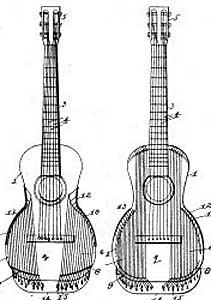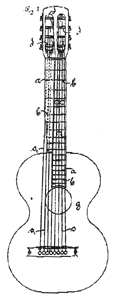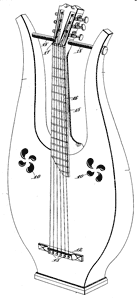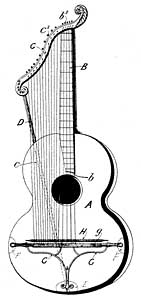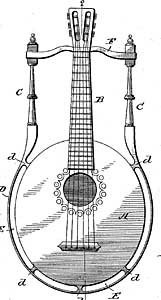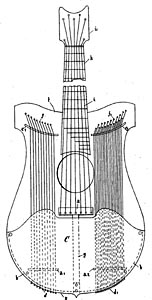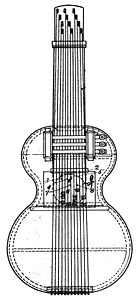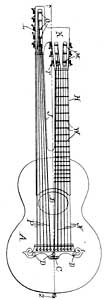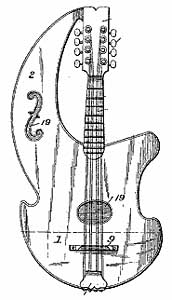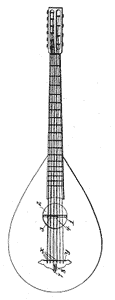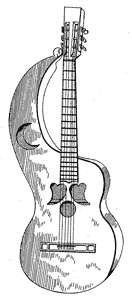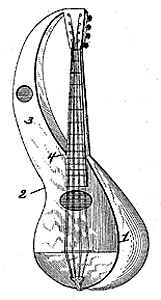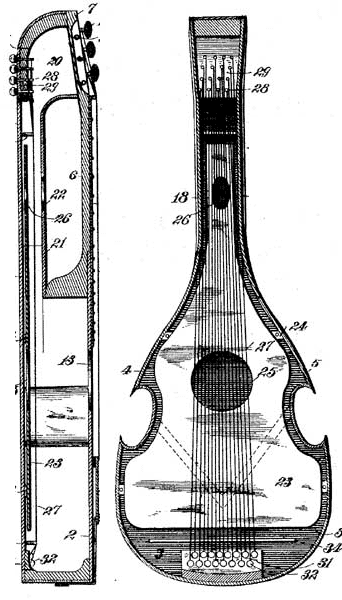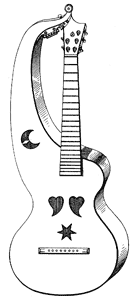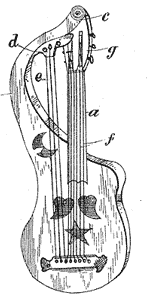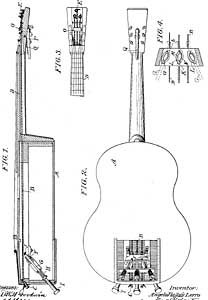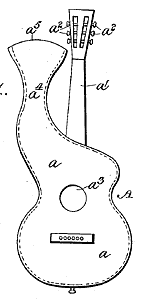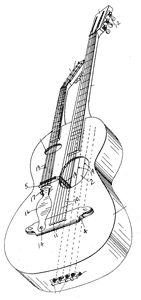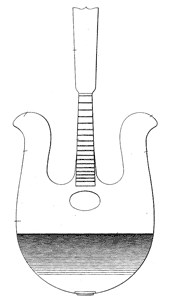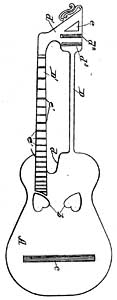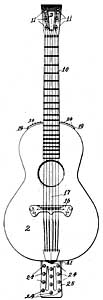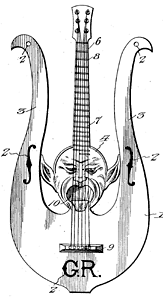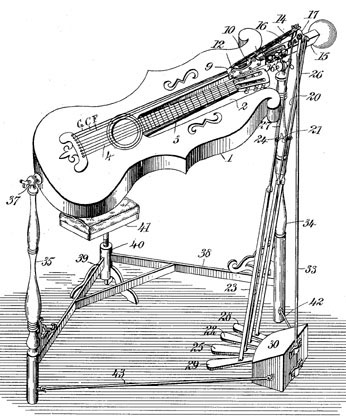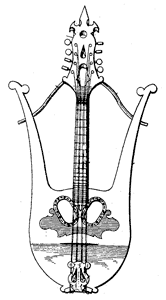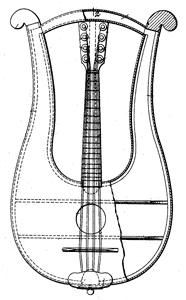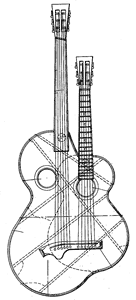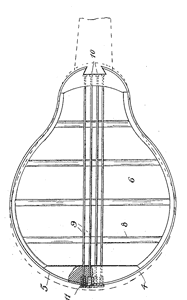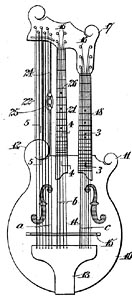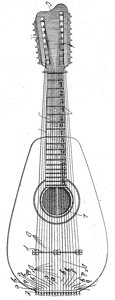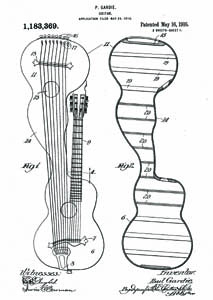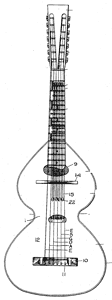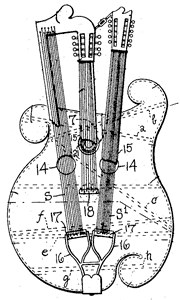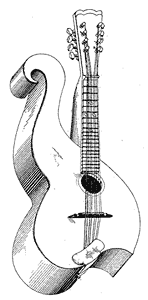 |
D52,539 |
Jun 14, 1918 |
Oct 8, 1918 |
McVey, George J. |
Lincoln, NE |
"Design for a Musical Instrument" |
Hollow-arms |
McVey harp mandolin |
|
The body shape is a virtual copy of Knutsen's harp mandolins, introduced at least eight years earlier. The arm shape is slightly different. One example, with a somewhat different shape, is known. What is the meaning of the 3-1/2 year patent term?
D52,539
D52,539b |
 |
312,840 (German patent) |
Jun 9, 1918 |
Jun 13, 1919 |
"Harmonie" |
Cassel, Germany |
"Mandolinen-ähnliches
Saiteninstrument"
(Mandolin-like Stringed Instrument) |
Related Instruments |
Zither-Mandolin |
|
Pretty simple, if impractical. A thin, flat-back
mandolin (or mandola) combined with a 24-string zither. No
examples known. 312,840
|

337,166
349,307
|
337,166 (German patent)349,307 (addendum) |
Jun 20, 1920 |
May 25, 1921 |
Wichmann, Gottfried |
Magdeburg, Germany, Stettin, Germany |
"Saiteninstrument nach Art einer Gitarre" (Stringed Instrument
Like a Guitar) |
Harp guitars, non-specific forms |
Gottfried's pitch-changing sub-basses harp guitar |
|
Gottfried's
very unique harp guitar designs are, amazingly, not the focus of his
patent. In fact, they are not discussed at all, but appear to just be
fanciful hypothetical examples to illustrate his true invention - the
elaborate sub-bass pitch-changing and muting apparatuses. Here's the
gist: At the top of the bass arm is a "bridge-like" capo-device
that raises all basses a half-step via a lever. The picture doesn't show
very well how this device ("n") would tilt up to touch the
string, but it obviously does. Below that is a device for raising
individual basses a more substantial interval; you simply stretch and
slip the string under a stationary hook lying just under the
strings, which pulls the string against another nut ("h").
Lastly, there are rubber stoppers near the bridge; as with the hooks
above, you stretch and slip the string under the stationary rubber
pad to mute any individual strings you choose to. This is all very clever and practical! No examples known. |
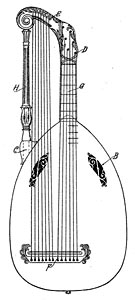 |
346,447 |
Nov 6, 1920 |
Jan 2, 1922 |
Lührs, Johann |
Rüstringen, Oldenburg |
"Harfenlaute" |
Hybrids |
Lührs Harp-lute |
|
Not to be confused with the Light harp-lute family, this
is a unique lute-guitar with a different form of theorboed bass
extension than the standard forms. A pillar supports the 7-sub-bass
extension. The back is bowl-shaped as in the hybrid lute-guitars. No
examples known, but a somewhat similar
Harfen-Lauten (with either 9 or 12 basses!), likely under this
patent, was sold by the Otto Windisch company.
346,447 |
 354,922 |
354,922 (German patent) |
Aug 10, 1921 |
Jun 16, 1922 |
Rehbach, Rudolf |
Nürnberg |
"Bassgitarre" |
Harp Guitars, Composite Forms |
Rehbach's "multi-task sub-bass" harp guitar (Fixed version and
Multi-angle, removable version) |
|
Rehbach offers some very interesting inventions in this
patent - I hardly know where to start! The one on the left is more
straightforward - it is a combination guitar and bass double-neck mixed
with a harp guitar. There is a normal guitar neck on the right, a
6-string fretted bass neck on the left, and 4 floating basses
in-between. One can play just the guitar neck, or just the bass
neck, tuned (low-to-high) D-G-C-F-Bb-Eb. The 4 remaining
sub-basses are
G#, F#,
C#, B. Thus, the combined total of all ten bass strings provide
most of a chromatic scale, and - with the fretted basses doubling as
harp guitar sub-basses, all ten strings can be used as harp guitar
sub-basses while playing the guitar neck. Rehbach calls this
technique his
"sound realm"
invention.
The necks are permanent
on this model. The instrument on the right has exactly the same
stringing, but the bass section (all ten strings, fretted and unfretted)
is not only removable (so that the instrument can just be used as
a 6-string guitar), but it can be cantilevered out to any angle
(the lowest string being moved furthest from the soundboard). I'm
not sure why - but it would be interesting to try to play
something like this! Finally, common both instruments is a strange
device (one single unit on the left model, two separate units on the
right) patented separately under 340,568
as a "Rotating Mechanism." This curious device consists of
"flip-up" levers that "fret" the strings at very locations near the
bridge - acting as a new saddle and shortening the string and raising
the pitch for "quick changes." Well, this might be fine for the
floating strings, but obviously it could not be used with fixed frets!
Clearly, they were used in conjunction with a complex
set-up for alternate frets shown on the 340,568 patent - calibrated
somehow to keep the whole scale intonated for each string at any new
pitch! Quite a complicated affair - could it possibly have worked?! No examples known. |
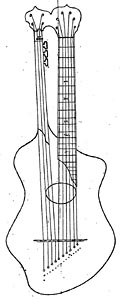
552,532 |
552,532 (French patent) |
Apr 25, 1922 |
Jan 24, 1923 |
Anfossi, Jean-Pierre |
Seine, France |
"Instrument musical dérivé
de la guitare" (Musical Instrument derived from a Guitar) |
Harp Guitars, Form 2c |
Anfossi "super-guitar" |
|
I thank Daniel
Phillips, of the U.K., who read in this space my request for a
translation of the French patent, and supplied a very good one (I have
made slight edits). The gist of this new harp guitar (which
Anfossi boldly names the "supergitarre") include 4 specific
aspects. First is the strange body shape, designed to make
possible the layout of the strings. Second is the placement of the
(floating) bridge so that all ten strings (6 standard and 4 sub-basses)
remain centered on the body ("displacement of the bridge to the
right"). Third is the attachment point of the strings to the
soundboard (using "buttons" which I suppose are bridge pins
inserted directly into the top), which puts the highest string's
termination closest to the bridge and the lowest pitch string furthest
away for best soundboard vibration ("founded
on a profound acoustic calculation").
Lastly, there are 3 "keys" operated by the thumb that flip
down to "fret" the string, presumably at the half, whole, and
3 half-step position for each string, providing a full chromatic scale.
The details of this mechanism, are sadly missing both in description and
illustration. No examples known. |
 |
1,489,710 |
Jun 27, 1922 |
Apr 8, 1924 |
Olsen, Anton Gustav |
Drammen, Norway (U.S. patent) |
"Tone-enriching Device for Musical Instruments" |
Sympathetic string guitars |
Olsen "insertable internal sympathetic string board" |
|
Assuming you want a hinged or screwed-on back on your guitar, you can insert Olsen's sympathetic board (12 chromatic strings) for extra volume and sustain. Make sure you tune it before you close up!
1,489,710
1,489,710b |

1,472,991
203,630
378,099
96,262
553,933 |
1,472,991
(U.S.) |
Jul 16, 1922 |
Nov 6, 1923 |
Pribyl, Jaraslav |
Prague, Czechoslovakia |
"Guitar and the Like" |
Multi-neck guitars |
Pribyl "double fingerboard, finger-and-thumb-fretted
guitar" |
|
203,630 (U.K.) |
Mar 20, 1923 |
Sep 13, 1923 |
England |
"Improvements in Guitars and the Like" |
|
378,099 (German) |
Jun 24, 1922 |
Jul 3, 1923 |
Prague |
"Zupfinstrument" (Plucked Instrument) |
|
96,262 (Austrian) |
Jun 28, 1922 |
Sep 15, 1923 |
|
553,933 (French) |
Jul 13, 1922 |
Jun 1, 1923 |
|
Pribyl's eight-string guitar seems directly based on the
1891 Lindemann patent above. Pribyl’s two sets of strings (4 + 4,
rather than 5 + 3) overlap at the headstock, then diverge towards two
tailpieces arranged in juxtaposition on the belly. Pribyl (like
Lindemann) believed that the overlapping of strings made it more
convenient for playing with the thumb, and greatly enlarged the compass
of the instrument. On Pribyl's the nut for the lower (thumb) strings is
placed to increase the string length by one semitone over the upper set. No examples known.
|
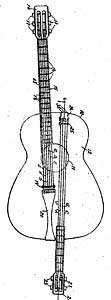 |
1,618,626 |
Nov 10, 1923 |
Feb 22, 1927 |
Altpeter, Franz W. |
Chicago, IL |
"Fretted Musical
Instrument" |
Harp guitars, Form 2a |
Altpeter "removable
neck harp guitar" |
|
One of my pet favorites, which I discuss at length in a
special page on Altpeter (under Encyclopedia of Makers). The sub-bass
neck can attach to either end of the body, and the sub-bass strings are
on the treble side of the neck strings. No examples are known of either
this version or an advertised "Double Bass Guitar," but a
"Double Bass Uke" is known (I'm the lucky owner).
1,618,626
1,618,626b 1,618,626c
1,618,626d 1,618,626e |
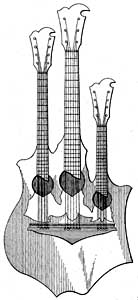 |
D72,433 |
Jun 14, 1926 |
Apr 12, 1927 |
Montfort, Adolph |
Chicago, IL |
"Design for a Stringed Musical Instrument" |
Multi-neck guitars |
Montfort triple-neck
guitar-mandolin-mandola |
|
Montfort's very cool triple-neck appears to include guitar, mandolin and octave-mandola. No examples known.
D72,433
D72,433b |
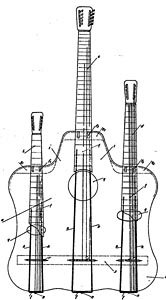 |
445,860 |
Jul 8, 1926 |
Jun 18, 1927 |
Köthe, Emil |
Bayreuth |
"Zupfinstrument" ("plucked" instrument) |
Multi-neck guitars |
Köthe's triple-neck |
|
Köthe's less-than-cool triple-neck appears to have
similar scale lengths , with 10 strings on the longest neck. I have yet
to translate this patent to analyze the mechanical features.
445,860 |

1,684,467
1,684,467b
1,684,467c
|
1,684,467 |
Apr 30, 1923 |
Sep 18, 1928 |
Boothe, Albert |
Colfax, IA |
"Stringed Musical Instrument" |
Harp guitars, Form 4 / Hybrid instruments |
Boothe "sirelin" |
|
A strange guitar and zither combination. Boothe includes 3 "bass or
accompaniment strings" on the body, which can be played open or fretted like a zither. He states that it is played "like a Hawaiian guitar" - presumably this refers to playing flat, on the lap, in zither fashion - although I
think he also allows for standard guitar playing position (I may be wrong - there are so many conflicting, poor descriptions). Coincidentally, there are only 4 strings on the neck, tuned in fifths,
zither-fashion - so this is a genuine new "hybrid" - a sort of zither/lap dulcimer/harp guitar. However, it is much more complicated than that - as there are
two bridges for both sets of strings, which can apparently be fretted and plucked at various locations between the assorted nuts and bridges. I gave up trying to figure it out. The Patent Office couldn't believe it either - it took them 5 years to grant his patent. No examples are know - if any finds a genuine "sirelin," let me know! |
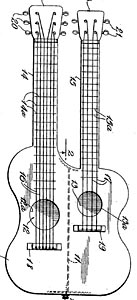
|
1,828,315 |
Feb 28, 1931 |
Oct 20, 1931 |
Cavicchioli, Dante |
New York, NY |
"Stringed Musical Instrument" |
Multi-neck guitars |
Cavicchioli body-baffle double-neck |
|
This is an otherwise standard double-neck instrument -
the patent shows an example of a 6-string guitar combined with a
4-string tenor guitar - with the exception of a fairly silly partial
wall that rotates up underneath either side of the top, or hangs
straight down bisecting the body somewhat between the two
"sections." The intent is to move the flap to quickly allow a
change of body air volume and thus, tone, when switching between the
necks. No examples known.
1,828,315 |
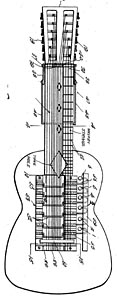
1,895,383
|
1,895,383 |
May 4, 1932 |
Jan 24, 1933 |
Sullivan, Roy M. |
Atlanta, GA |
"Stringed Musical Instrument" |
Related Instruments |
Sullivan steel guitar with changeable accompaniment chords |
|
Sullivan's patent is extremely complicated - so
good luck! What he's done is to create a very complex steel guitar
wherein one can play lead on the 3 melody strings (with the first and
second fingers), while strumming accompaniment chords and bass with the thumb. It
gets complicated because the chord section is a sort of poor man's
acoustic version of a pedal steel guitar - i.e.: a vast amount of chords can be
obtained by pressing chord-shifting buttons with the third and fourth
fingers, and pitch-changing every other course of chord strings (strung
doubled or tripled) by sliding a lever with the knee! Oh, there's also a
wrist-controlled damping bar for the chord section. All this while
playing all the parts, mind you! |
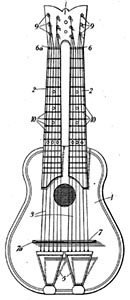
403,822
|
403,822 |
Aug 14, 1933 |
Jan 4, 1934 |
Richardson, Edward |
Nottingham, U.K. |
"Improvements in Stringed Musical Instruments" |
Multi-neck guitars |
Richardson "Duo Guitar" (double-neck 6-string/steel guitar) |
|
Actually, this is so obvious I'm surprised I've never
seen one. Richardson combines a standard 6-string guitar neck and a
standard 6-string steel guitar neck on one instrument. The bridge and
nut are higher on the steel (left) side. Both necks utilize raised metal
frets, the steel neck as markers only. Richardson claims that this is
the first double-neck guitar with a single headstock, and the first
double-neck with one set of strings raised for steel playing. It may be
true, for all I know! Surely there must be an example out there
somewhere...
Update, May, 2008: There are examples - this is from the grandson:
"I thought you might be interested to see these pictures of a
Ricardo Duo Guitar Patent 403,822. My great grandfather was Edward
Richardson and I have had one of the original guitars handed down to me,
I believe there are others which other relatives may have including the
original made by Edward himself (he was a cabinet maker by trade, as
well as a music teacher). I understand from my grandmother that all of
the Duo Guitars made, were made for his students, and we think less than
20 were made although the number on mine is 62 we believe that he stuck
the stickers on for higher numbers, as my uncle has the first 20 or 30
stickers unused, but I can not confirm the number made. I'm afraid it's
not in brilliant condition as the photos show. But I hope it is of some
use to you. I feel I should send you these photos as it was because of
your website I was easily able to find the copy of the patent, many
thanks. If you have any questions I'd be more than happy to try and
answer them for you, my grandmother who was the youngest of Edwards
children was taught by him and I believe has photos of him playing in a
band with the guitar and so probably has more information that I could
get. Regards, Simon Noakes, Nottinhamshire, UK" |

2,250,402 |
2,250,402 |
Aug 26, 1940 |
Jul 22, 1941 |
Towell, Thomas E. |
Hot Springs, AR |
"Guitar" |
Harp guitars, Form: Other |
Towell's interlacing out-of-the-soundhole sub-basses harp guitar |
|
I don't know what to call this thing. It looks
really cool, but could it be built, and more to the point, played?
The 10 sub-bass stings are attached to a long open frame that
is inserted through the soundhole of the guitar at a steep angle.
The bottom of the frame is secured to the inside back bottom edge, while
the head is supported by an attractive harp-like bracket (seen in
profile). The sub-basses activate the soundboard by a typical bridge on
the underside of the top. Now it gets interesting.
For everything to fit of course, the standard 6 strings and the sub-bass
strings must be staggered where they cross. So between each of
the 6 strings is a bass string (2 between the D and G)! In this
way, one can theoretically strum or play the guitar strings over the
soundhole unencumbered by any bass strings in the way (except of course,
for all these strings slapping together and banging like crazy).
One then simple moves up a bit to play the sub-basses (while fretting
underneath them! It goes without saying that having the first
sub-bass way the hell past the high E on the neck would be the last
straw... No examples known - would love to see this one! |
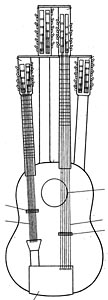
945,899 |
945,899 (German patent) |
Jul 27, 1954 |
Jul 19, 1956 |
Rösler, Philipp |
Erlangen, Germany |
"Saiteninstrument mit mehreren Griffhälsen"
(Stringed Instrument with Several Necks) |
Multi-neck guitars |
Rösler double-sided
quadruple-neck guitar |
|
Outrageous! Combining two double-neck guitars on one
body - two necks for each side! What a handful! The string
count is 6, 8, or 10 for each neck - no idea what tunings would have
been used. Note the brackets joining all the headstocks,
presumably for strength. No examples known. |

1,184,425 |
1,184,425
(French patent) |
Oct 16, 1957 |
Feb 2, 1959 |
Mouroux, Louis |
Seine, France |
"Cithare perfectionnée" (Improved
Zither) |
Harp guitars, Composite Form |
Mouroux open-arm pneumatically-capoed sub-bass harp guitar |
|
This amazing creation features an abbreviated
hollow-arm, chopped off to allow sound to emanate into the players chest
I suppose. The more interesting part though are the pneumatic
foot-operated "capo-bellows" (my term)! There are three
foot pedals attached by tubing to the bass neck; each inflates a
separate bellows that forces the three sub-bass strings down against a
fret, changing the pitch by either 1, 2 or 3 half-steps. No
examples known of this rather recent and creative French invention. |
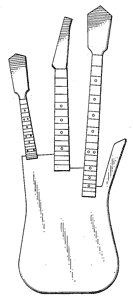 |
D186,688 |
Jun 22, 1959 |
Nov 17, 1959 |
Cogdell, Nelcie S. |
Orange, CA |
"Stringed Musical Instrument Body" |
Multi-neck guitars |
Cogdell electric triple-neck
guitar-mandolin |
|
A triple-neck patented in 1959, in Orange County -
coincidentally Leo Fender's neighborhood. Fender rip-off? Looks like 2
guitar necks, 1 with a Fender-ish headstock, the other fairly standard,
along with a mandolin neck - all on an obvious solid body. No examples
known.
D186,688 |
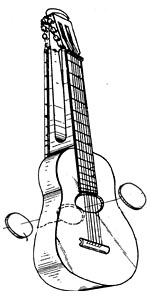 |
3,636,809 |
Jul 7, 1970 |
Jan 25, 1972 |
Ezaki, Hideyuki |
Hamamatsu, Japan |
"Stringed Musical Instrument" |
Multi-neck guitars |
Ezaki's double-sided double-neck |
|
Ezaki is not the first (nor the last) to try a
double-sided guitar, with a neck on each side. His features the
headstocks connected at the ends for support, and mainly the two
"soundhole plugs" - which can be inserted or removed on either side for
altering the tone of the currently played side. Or you can leave
them both out so that the back side set will vibrate sympathetically out
the front. Clever! No examples known. 3,636,809 |
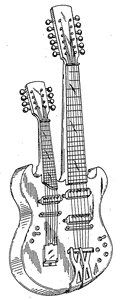 |
D224,841 |
Mar 18, 1971 |
Sep 26, 1972 |
Dawson, Calvert A. |
East Baton Rouge, LA |
"Stringed Musical Instrument" |
Multi-neck guitars |
Dawson electric guitar & mandolin
double-neck |
|
Your basic electric (kind of Gibson SG-shaped) with 12-string guitar and mandolin necks. Many makers have since produced similar versions.
D224,841 |

3,392,618
1,797,328 |
3,392,618 |
Mar 18, 1966 |
Jul 16, 1968 |
Pelensky, Walter J. |
Philadelphia, PA |
"Multirange Fretted Guitar Type Instrument" |
Multi-neck guitars |
Pelensky's kobza-guitar |
1,797,328
(German patent) |
Sep 13, 1968 |
Feb 17, 1972 |
"Gitarrenartiges Musikinstrument mit Bünden
für mehrere Tonlagen" |
|
A unique multi-neck that reminds me a bit of the 1898 Ward "Harpo-Guitaret"
above - as it uses a similar split-fretboard concept. Pelensky
frequently refers to the Ukranian kobza in describing this instrument,
so I imagine that was his main (or preferred instrument). He
mentions drawbacks of the kobza and (unfretted) bandura, and his answer
- an improved, chromatic "multi-range instrument. He describes the
3 registers of each neck (bass, tenor and soprano) and the many
instrument tunings that might be used for these various necks - banjo,
cittern, guitar, mandolin, mandola, and of course, kobza. |

2,415,853 |
2,415,853
(French patent) |
Jan 26, 1978 |
Aug 24, 1979 |
Abel, Roger Alain |
France |
"Dispositif complémentaire destiné à augmenter l'étendue
d'une guitare" |
Harp guitars, Form: Other |
Abel's two-by-four sub-bass attachment |
|
I apologize for being so derogatory in choosing a
"popular name" for this invention, but that's what it reminds me of.
A plank of wood, held off the back of the guitar and secured (unlikely)
by a tailpiece connection and headstock brace. The 7 (shown)
sub-bass strings are then strung over the guitar to mount only to this
attachment, tuned via zither or piano pins. One advantage I see is
that one could have almost unlimited length for the sub-bass strings!
I haven't translated this yet - I may be missing something! No
examples known of yet another strange (and fairly recent) French
invention. |
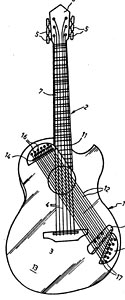
2,565,016 |
2,565,016(French patent) |
May 25, 1984 |
Nov 29, 1985 |
Sternheimer, Joël |
France |
"Instrument à cordes, du type des guitares, pour
la modélisation acoustique des
particules élémentaires" |
Sympathetic string guitars |
Sternheimer Sympathetic String Guitar |
|
Co-invented with Philippe Flejo, Jean-Pierre Favino and
Jean-Claude Trebuchet, this attractive modern guitar has a bank of
sympathetic strings running diagonally under the main strings. If the
patent (working on translation) describes plucking these strings
musically, then we elevate it to harp guitar status. I haven't yet seen
this exact guitar, but several makers have incorporated the concept in
various ways. |
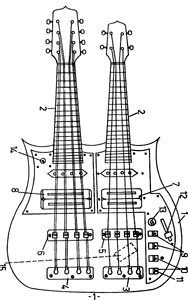 |
8,501,179 |
Mar 8, 1985 |
Aug 14, 1986 |
Salomão, Paulo Cesar |
Brazil |
"Instrumento Musical" |
Multi-neck guitars |
Salomão Electric Double-neck Mandolin |
|
Another electric double-neck - this one combining a
double-course and single-course mandolin.
8,501,179 |
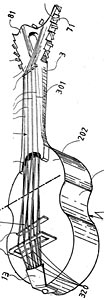 |
2,643,182 |
Feb 16, 1989 |
Aug 17, 1990 |
Artru, Regis |
|
|
Multi-neck guitars |
Artru's double-sided
multi-neck |
|
2,643,182
I believe this is a guitar with two sets
of strings, strummed at one time. The second set runs under the
fingerboard, and it looks like strings are fretted by depressing buttons
with the thumb - am I right? |
 |
2002 / 0162442 A1 |
Oct 30, 2001 |
Nov 7, 2002 |
Bryan, Harvard Jasper |
Magnolia, AR |
"Stringed Musical Instrument With Soundbox Extension" |
Related Instruments |
Bryan's Lyre Mandolin |
|
Boy, they just don't give up! After all the many
lyre guitars and lyre mandolins through the ages, Mr. Bryan decides to
re-invent the lyre mandolin. He mentions the famous Gibson lyre
mandolin, and also that no lyre mandolins were ever put into production
(many were, but so far, I haven't seen his!). 2002
/ 0162442 A1 |

